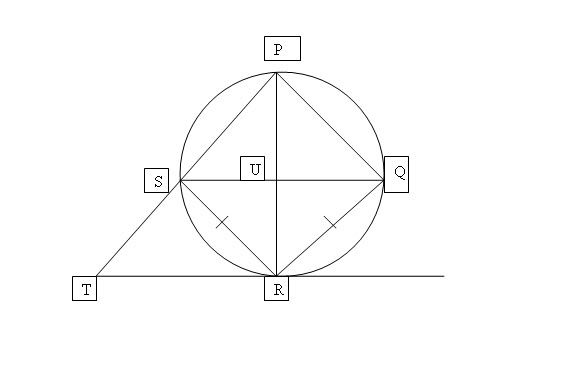Plane geometry (urgently need help!)
-
The diagonals of cyclic quadrilateral PQRS intersect at U. The circles's tangent at R meets PS produced at T. If QR = SR, prove that
PR x ST^2 = UR x RT^2
Haven't been able to sovle this ever since my MYE. Can someone help?

-
Originally posted by bonkysleuth:
The diagonals of cyclic quadrilateral PQRS intersect at U. The circles's tangent at R meets PS produced at T. If QR = SR, prove that
PR x ST^2 = UR x RT^2
Haven't been able to sovle this ever since my MYE. Can someone help?

After 2 hours of work...I finally got a random guess answer which is most likely partially wrong, but can be used to work towards the correct answer.
Things you need to know: PR = RT, PSU AND PTR are similar triangles.
UR / PR = ST / PT
UR / PR = (ST)^2 / (PT)(ST)
UR / PR = (ST)^2 / (PT)(PT - SP)
UR / PR = (ST)^2 / (PT^2 - (PT)(SP))
UR / PR = (ST)^2 / (PT^2 - (1/2(PT) X (PT)))
UR / PR = (ST)^2 / (PT^2 - (1/2)(PT^2))
UR / PR = (ST)^2 / (1/2)(PT)^2
UR / PR = (ST)^2 / (1/2)((RT)^2 + (RP)^2)
UR / PR = (ST)^2 / (1/2)((RT)^2 + (RT)^2)
UR / PR = (ST)^2 / (RT)^2
PR X (ST)^2 = UR X (RT)^2
Discuss any mistakes you find in my workings.
-
edit: answer already above
-
ok finally got some time to take a look
this is what I would do
angle RSQ = angle SQR (isos)
angle SQR = angle SRT (alt. segment)
Hence angle RSQ = angle SQR
==> SQ is parallel to RT
==> PSU and PTR are similar trianglesUsing tangent secant theorem,
ST * PT = RT^2 ------------------- (1)Using intercept theorem,
PS / ST = PU / UR
PS / PU = ST / UR
Also,
PS / PU = PT / PR (similar triangles)Hence,
PT / PR = ST / UR
PT = ST * PR / UR ---------------------- (2)
Sub (1) into (2)
ST^2 * PR / UR = RT^2
PR x ST^2 = UR x RT^2 (shown) -
***********************************************************************************************
wait... on second thoughts, after looking at Forbiddensinner's solution, I can combine our solutions together to become an even shorter solution
After proving the similar triangles,
Using intercept theorem,
UR / PR = ST / PT
UR / PR = ST^2 / (PT)(ST)Using tangent secant theorem,
ST * PT = RT^2Hence,
UR / PR = ST^2 / RT^2
PR * ST^2 = UR * RT^2